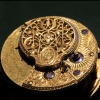-
Recently Browsing
- No registered users viewing this page.
-
Topics
-
Posts
-
Thought I had to share this - last time I cleaned out a deep fat fryer there was less mess than this. Another pin pallet movement. Unsurprisingly dunking it in Castrol GTX didn't fix the broken mainspring which is the only issue I've found. Any tips for the dial? Also covered in oil. Cleaned up quite nicely
-
By Neverenoughwatches · Posted
Hi Nev . No i didn't try this balance in the movement as it didn't run and the deformed staff broke when i removed the roller. Problem is what i think is the correct staff for this movement, the hub seat, roller and collet profiles are all too small for those parts of the assembly. The movement listed on Ranfft's site is correct my movement and the nos staffs i have match the ronda measurements. I can only assume that the wheel , roller and collet openings have all been broached to make them fit an oversized staff, both staff pivots had also been modified. -
Yes, threw it on the demagnetizer before I cleaned it to be sure. This picture doesn't show it well, but I can definitely see liquid where the turns meet up.
-
My newest 404 candidate, a late '60's / early '70's Waltham with a UTC 33 / Seiko 6601 17 jewel automatic movement. It needed a new crystal and I put on a strap from my Strap Graveyard. The timegrapher was a snow storm before servicing but it cleaned up nicely. I really like the funky font used for the hour markers.
-
By nevenbekriev · Posted
Hi Rich, the main problem with the balance is if the roller is from this movement. Did Yoy try if the balance interacted correctly with the lever? You can use suitable (by size) balance/hairspring couple from You pile of balances, but the roller must be for this lever (original for the calibre). Not that making roller is impossible, but it is easier to have one.
-







Recommended Posts